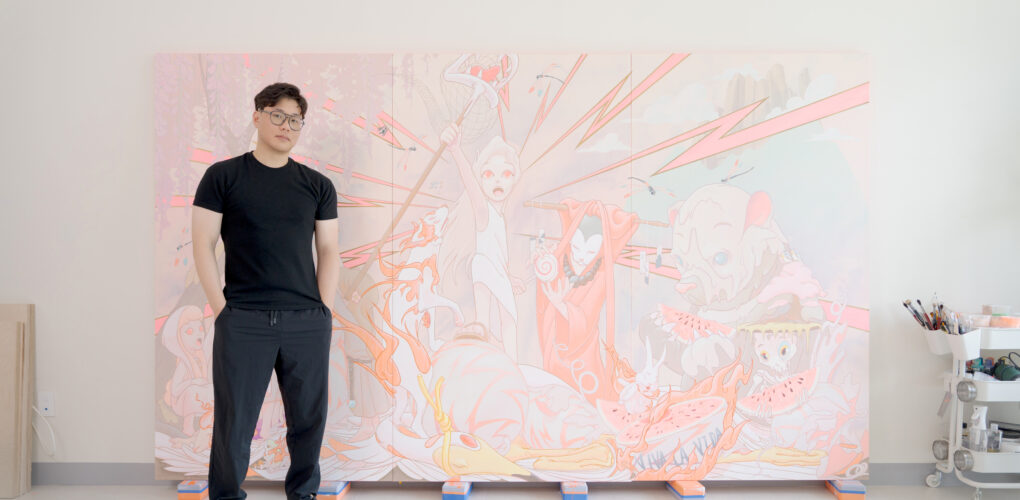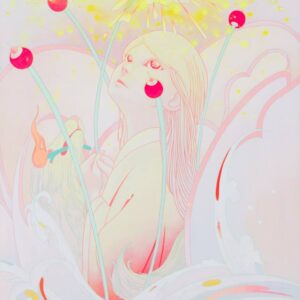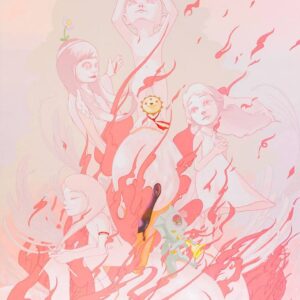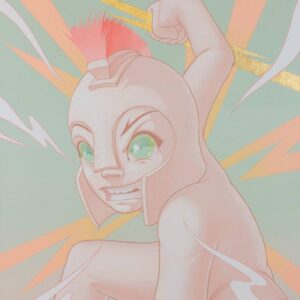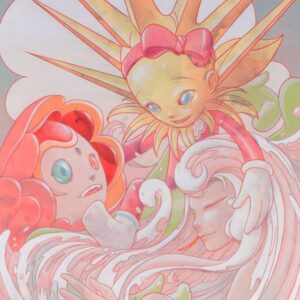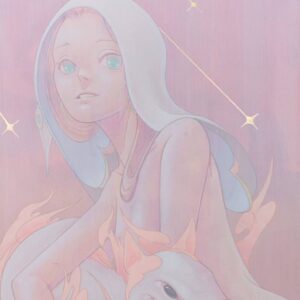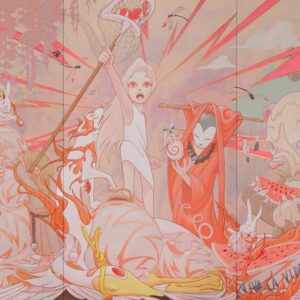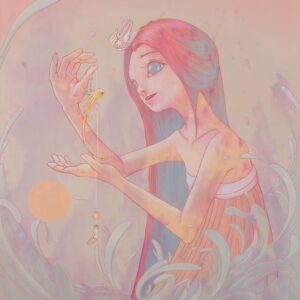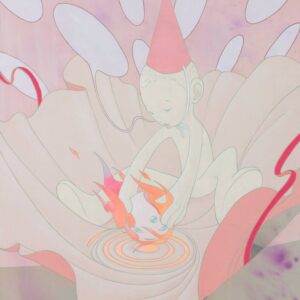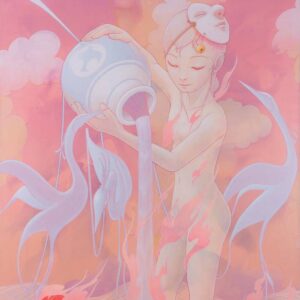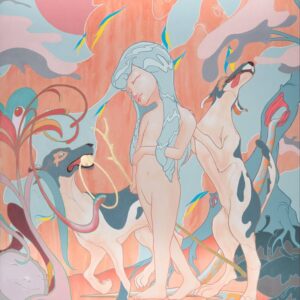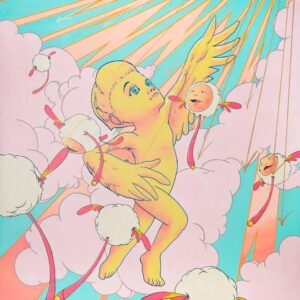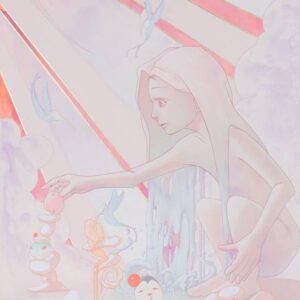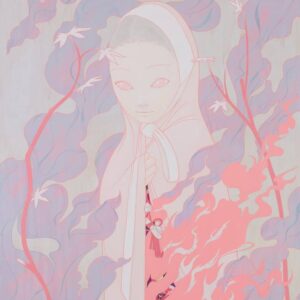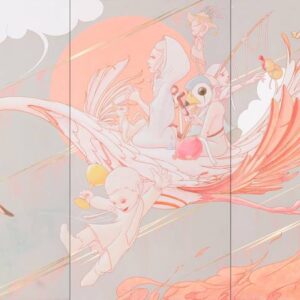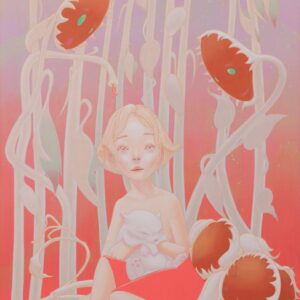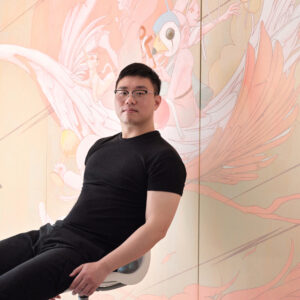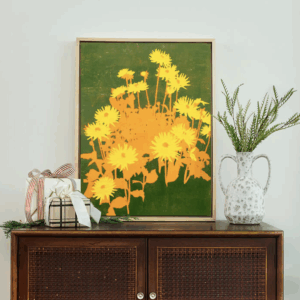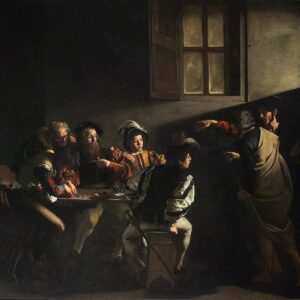One to Watch
 Artist Oh Kyeong-hoon Envisions Hope
Artist Oh Kyeong-hoon Envisions Hope
Artist Oh Kyeong-hoon constructs fantastical, hopeful worlds in his brightly colored and delicately drafted paintings. He transforms personal memories and universal emotions into whimsical yet deeply resonant visual narratives.
Kyeong-hoon received his BFA from the Digital Media Design department at Kaywon University. His varied exhibition history has taken him around the world, from Seoul to Dubai and Paris, and Kyeong-hoon first caught our eye in our Frieze inspiration roundup. Explore the optimism radiating from the artwork of this month’s One to Watch.
Tell us about who you are and what you do. What’s your background?
I am a visual artist based in Seoul, South Korea, specializing primarily in acrylic paintings. My background is far from that of a model student; I was a boy who loved playing outdoors every day. I had absolutely no interest in art, but I registered for an art academy with the simple, innocent motive of getting a chance to talk to a girl I had a crush on–a naive strategy, I know! It was there that I experienced an unexpected turning point in my life.
Despite not being particularly skilled at drawing, the academy teacher complimented me, saying, “You draw well.” For a child who had never once been praised for excelling at anything in life, the act of making art became a source of immense joy and my first pathway to recognition. That overwhelming feeling and the positive experience propelled me to become the artist I am today. I use that original sense of joy and validation as the driving force behind my continuous work, striving to create art that brings happiness to both myself and others.
What are the major themes you pursue in your work?
The core message of my work is condensed into four key themes: dreams, hope, tranquility, and growth. Rather than presenting a grand philosophy, I focus on capturing the universal emotions shared by those living in the current era. Occasionally, I weave in narratives based on my own personal experiences.
The piece that best demonstrates this is Viva La Ttu Ttu Tti Va. This painting was inspired by an early memory of working in a watermelon field for a day, where I first encountered the feeling of frustration. Simultaneously, I became aware of the disparity between the high value of the precious specialty ‘Mudeungsan Watermelon’ from my hometown, Gwangju, and the grueling reality of the watermelon field where I labored. This work is a lighthearted story about growth and victory that emerged from that imbalance and bitterness. I was inspired by works like Coldplay’s Viva La Vida and the self-titled paintings by Delacroix and Frida Kahlo, all creations that sing of life despite enduring hardship.
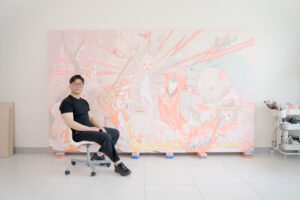
The watermelon field scene, revisited through my memory, is filled with witty elements. The grumpy little frog in the bottom left corner represents the unscrupulous boss who denied us water and breaks. The frustrated co-workers, exhausted by the heat and labor, are depicted as kicking rabbits. I was certainly annoyed that day! The girl in the center of the painting symbolizes our spirit, my spirit that overcame all adversity. I chose to render all the figures in a cute, cheerful way, hoping that the difficult memory would be remembered with humor. Therefore, the painting is light, and I never want it to feel heavy to the viewer.
Ultimately, my goal is for viewers to share the emotional landscape I felt during the work’s creation. My ambition is to capture diverse expressions, be it anger, joy, or sadness, that arise even within the single emotion of hope. I aim to help the audience interpret the work through their own experiences, sparking memories of their personal narratives and dreams.
Can you walk us through your process for creating a work from beginning to end?
My creative process begins with the most challenging part: finding inspiration. Since ideas are unpredictable, I often gain them by taking long walks while listening to music, watching films, or revisiting past memories. When inspiration strikes, I immediately capture it with a rough sketch on my phone or in a notebook. In the studio, I first use my drawing book to flesh out the initial ideas, working on the early design and composition. I then transfer this to my iPad to conduct countless digital revisions to refine the figures and structure, and finalize the color palette. Next, I print the finalized sketch and use the carbon paper transfer method to trace the design onto the canvas. Though this method is ‘old-school,’ I love the analog feel of the pencil tracing the lines—it’s an essential ritual.
For the painting stage, I use acrylics but frequently incorporate the blotting or blending techniques often seen in traditional Eastern painting or watercolor. This adds a sense of mystery and higher density to my work. Crucially, I never apply thick layers of color at once; instead, I build up each hue with a minimum of seven thin layers, a process known as glazing. This maximizes the color depth and density, a key feature that unfortunately isn’t fully captured in photographs. I continue making necessary revisions during the actual painting process, and finally, I seal the work with a mixed layer of satin and matte varnish.
Who are your biggest influences and why?
The person who most significantly influenced my decision to start painting again is unquestionably the artist James Jean. Working as a designer when I encountered his work, I was so shocked and utterly captivated by his dreamy and mysterious style that his art essentially compelled me to return to the canvas. I continue to explore the aesthetics of his style deeply in my current practice. I often joke that James Jean is my Grand Master, and I am his disciple—though he is entirely unaware of my existence. I’m also significantly influenced by other visual artists I admire, notably Casimir and Audrey Kawasaki.
Beyond visual artists, the presence of a great spiritual mentor is equally important to me. The renowned Korean Buddhist monk, Pomnyun (법륜스님), is my spiritual anchor. From him, I learn a crucial lesson: instead of blaming external circumstances or fate for life’s hardships and dissatisfaction, one must look inward and confront reality honestly. His teachings instill in me the detachment necessary to focus on the best effort I can make now, without being overly fixated on destiny or the final outcome. I strive every day to practice this wisdom, hoping that his guidance is reflected not only in the theme of tranquility in my artwork but also in my everyday words and actions.
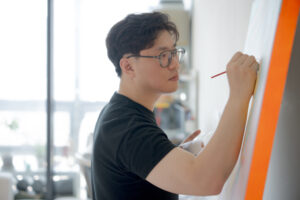
How does your work comment on current social and political issues?
My work is very much a commentary on current social issues, specifically addressing the internal struggles of people living in my generation. While the paintings primarily depict scenes of tranquility or the pursuit of hope, this is a paradoxical way of pointing to the severe lack of dreams and hope being experienced by the younger generation.
I believe the most essential thing for a person is hope—the belief that life can get better. However, this is not just a Korean problem, but a worldwide phenomenon where young people are giving up on major life milestones due to overwhelming economic and social pressures. This extensive global issue, which manifests as Korea’s N-Po Generation, Japan’s Satori Generation, and China’s Tang Ping movement, is often described as the ‘Generational Opt-Out’ or the ‘Burnt-Out Youth’ retreating from traditional expectations. Furthermore, when children’s dreams are confined to lucrative careers like doctors or corporate jobs, it signals that the world is becoming less interesting, and dreams are losing their pure essence.
I believe the root of this problem lies with the governments and societies that have failed to solve these structural issues, not with the youth themselves. My work does not directly address these problems; instead, my bright and positive visual language speaks about hope and dreams, prompting a positive reflection on the problem. I want my art to resonate with my contemporaries, reminding them that hope is the engine that drives life forward. My personal goal is to eventually succeed and run a scholarship foundation to support children in pursuing their purest dreams.
How do you hope viewers respond to your works? What do you want them to feel?
I sincerely hope my work serves as an ‘internal trophy’ for self-reflection for every individual who views it. I envision this trophy fulfilling two critical functions: Firstly, for those who have lost their dreams and hope, I want my art to be the solid kindling capable of reigniting the fire of passion in their hearts. Since dreams and hope are the most powerful forces that move people, I hope my paintings grant them the strength to embark on their lives anew.
Secondly, for those who have already achieved their ideal goals, I want my pieces to be a cherished monument that allows them to look back with gratitude and fond memories at the difficult journey they overcame. I view us as comets traveling the purgatorial vastness of space aboard a rocket called Earth. Like comets, we meet each other purely by chance and travel together or pass by in brief moments. To truly love and embrace each other during these fleeting encounters, I believe the most crucial prerequisite is to cultivate oneself well, and I believe that driving force can be found in dreams and hope.
I don’t wish to impose an abstract and idealized responsibility—like that of a Buddha or Christ—by insisting that “one must care for others regardless of personal distress.” Instead, my hope is that viewers will be inspired by my work to focus on their inner selves and find genuine tranquility, thereby gaining the capacity and strength to offer hope, kindness, and tolerance to others. Ultimately, if my paintings can fill the audience’s hearts with positive energy and laughter, I sincerely hope this will serve as a small seed toward building a more wonderful and interesting society together.
Do you prefer to work with music or in silence?
I definitely prefer to work with music. For me, it’s “No Music, No Life.” Music is not just background noise during the creative process. It is an essential element that amplifies my emotions and maximizes my concentration. Depending on the atmosphere of the piece, I listen to various genres, including classical, jazz, and contemporary music. The rhythm and melody of the music help organize the complex ideas in my head and allow me to unleash energy onto the canvas.
If you couldn’t be an artist, what would you do?
Honestly, a life without being an artist is difficult to even imagine. I never had a clear, distinct dream of what I wanted to be when I was young, so perhaps I might have lived an ordinary, uneventful life, relying on my family or working at a small company. That life wouldn’t necessarily have been bad, but it certainly wouldn’t have been as interesting as the one I have now.
However, the desire to live as an artist completely transformed me. In my twenties, even when I couldn’t earn money from art and was doing manual labor or washing dishes, the only thought in my mind was: “I must earn this money to continue my creative work.” My life today is still challenging, but I am simply grateful that I can continue my practice. For me, art is not just a profession; it is the sole reason for my existence. If I weren’t an artist, I wouldn’t have pushed myself to achieve positive goals like running the scholarship foundation I dream of. I truly believe my destiny is aligned solely with creative work.
